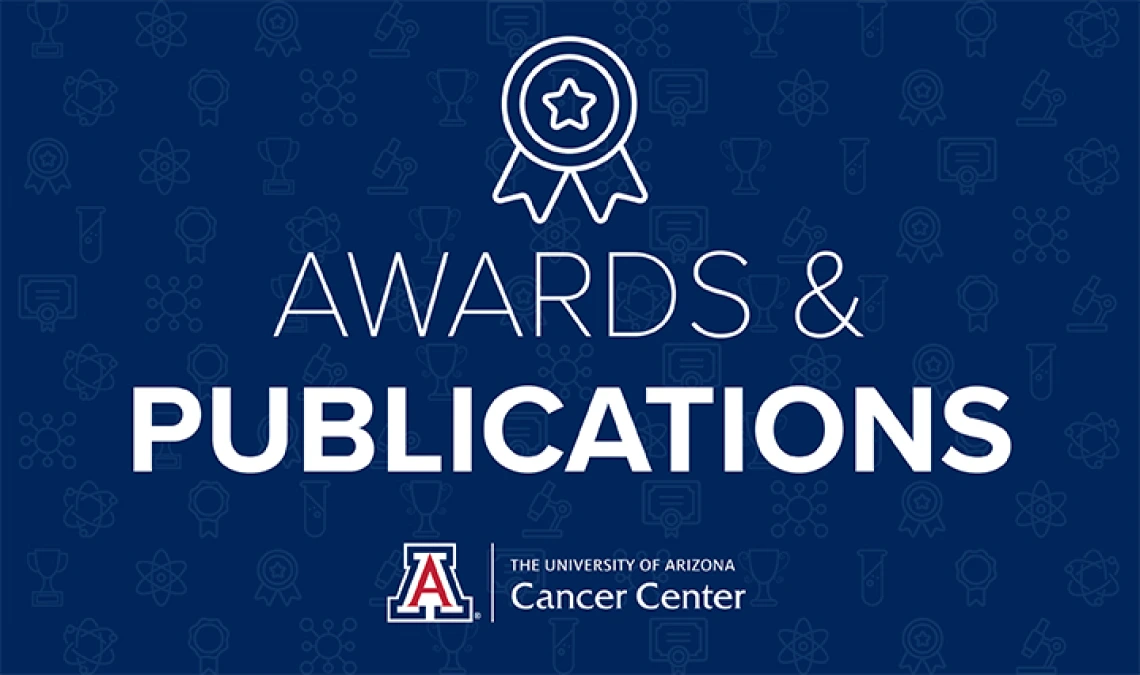Publications Update: October 2021


Karen Taraszka Hastings, MD, PhD
Karen Taraszka Hastings, MD, PhD
Cancer Prevention and Control Program, Research Member
Publication: Journal of Investigative Dermatology
Title: Solar Simulated Light Induces Cutaneous Squamous Cell Carcinoma in Inbred Mice: A Clinically Relevant Model to Investigate T-Cell Responses
Overview: Cutaneous squamous cell carcinoma is a common form of skin cancer caused by sunlight. To study this cancer in the laboratory, researchers use simulated solar light on outbred mice. Outbred mice are genetically diverse, which can be good thing. But the genetic diversity makes it effectively impossible to study the immune system’s T cell responses or make genetically engineered strains.
To overcome this limitation, Dr. Hastings’ lab worked with others at the University of Arizona to characterize the use of solar simulated light in commonly used strains of inbred mice. Their findings suggest that two of the strains make good models to study this cancer. In these strains, the immune system showed a similar pattern as in humans with the cancer: the immune system was activated early on in tumor formation and was suppressed as the cancer progressed. Researchers in Dr. Hastings’ lab are now creating cell lines from these tumors that can be transplanted back into mice to study a range of questions about cutaneous squamous cell carcinoma.
Dr. Hastings says: “Currently, there aren’t readily available and good cell lines to study squamous cell carcinoma, so cell lines made from this new model will be very beneficial. Ultimately, we want to interrogate the T-cell responses that control squamous cell carcinoma, as well as the response to immunotherapy, and find new ways to stimulate the immune response to kill squamous cell carcinoma.”

Setsuko K Chambers, MD
Setsuko K Chambers, MD
Bobbi Olson Endowed Chair in Ovarian Cancer Research
Cancer Biology Program, Research Member
Publication: Nature Communications
Title: Molecular and clinical determinants of response and resistance to rucaparib for recurrent ovarian cancer treatment in ARIEL2 (Parts 1 and 2)
Overview: Both platinum chemotherapy and poly (ADP-ribose) polymerase (PARP) inhibitors are commonly used to treat ovarian cancers. But they only really work in tumors that have trouble repairing their DNA via a specific pathway known as homologous recombination. Therefore, doctors check patient’s tumors before treatment to see if they have mutations in the DNA repair genes BRCA1/2 and RAD51C/D or have “genomic scars” caused by defective homologous recombination. However, the results from a large study with sites around the world, including the UArizona Cancer Center, indicates this approach could lead doctors down the wrong path.
The researchers studied tumor samples from women with recurrent ovarian cancer treated with platinum chemotherapy and PARP inhibitors. As predicted, tumors with BRCA1 and RAD51 gene mutations responded to therapy. But the study showed that an additional factor, known as epigenetics, plays an important role in determining whether the tumors were sensitive to treatment or not. Epigenetics refers to changes in how your genes work rather than changes to the actual gene sequence. Some women’s tumors had epigenetic “tags” that turned off an otherwise completely normal BRCA1 gene. These tumors responded to PARP inhibitor treatment but would have been missed by just sequencing the BRCA1 gene.
Making the story even more complex, these tags are reversible and can be affected by our environment and lifestyle so the tumor’s BRCA1 gene could be turned back on and become resistant to treatment, meaning that doctors need to look for epigenetic effects right before treatment.
Dr. Chambers Says: “There are several important lessons from this paper, including pointing out deficiencies in our current way of figuring out whether a tumor may be sensitive to PARP inhibitors. That is because epigenetic effects are critical to understanding resistance mechanisms. The genomic scar will remain in the tumor even when the epigenetic silencing is reversed. So even though the tumor is now platinum-resistant, the assay indicates they are still homologous recombinant-deficient, and doctors may waste time on an expensive treatment that will no longer work for the patient.”

Noel Warfel, PhD, is assistant professor of cellular and molecular medicine at the College of Medicine – Tucson.
Noel A Warfel, PhD
Experimental Mouse Shared Resource, Co-Director
Cancer Biology Program, Research Member
Publication: Oncogene
Title: Direct phosphorylation and stabilization of HIF-1α by PIM1 kinase drives angiogenesis in solid tumors
Overview: Tumors need a constant blood supply to provide the oxygen and nutrients needed to grow. To fill that need, some tumors hijack the process of angiogenesis, or the growth of new blood vessels. A research team led by Dr. Warfel discovered a mechanism that tumors use to keep blood vessels growing, driving cancer growth and invasion. During angiogenesis, a protein called hypoxia-inducible factor 1 (HIF-1) turns on many genes needed for blood vessel growth. When oxygen levels are normal, cells destroy HIF-1 to stop too much growth. But in the prostate and colon cancer tumors the team studied, a protein called PIM1 kinase prevented HIF-1 from being destroyed. When HIF-1 levels remained high, the tumors grew rapidly. Read more.
Dr. Warfel Says: “Normally HIF-1 wouldn't be turned on in healthy, oxygenated tissue. If we turn down PIM1, we might be able to turn off HIF-1 and reduce tumor angiogenesis and subsequent tumor growth, which has long been a clinical goal hampered by the lack of effective drugs that target HIF-1.”

Pavani Chalasani, MD, MPH
Pavani Chalasani, MD, MPH
Clinical and Translational Oncology Program, Research Member
Jessica A Martinez, PhD
Cancer Prevention and Control Program, Associate Member
Publication: Clinical Cancer Research
Title: Sulindac, a non-selective NSAID, reduces breast density in postmenopausal women with breast cancer treated with aromatase inhibitors
Overview: Denser, more fibrous breasts are a known risk factor for breast cancer and are screened through mammograms. The University of Arizona and Stony Brook Cancer Centers tested whether the NSAID sulindac could lower breast density in postmenopausal women when added to hormone therapy. At one year, women taking sulindac had lower breast density than at the start of the study. In contrast, there was no significant change in the group of women not taking sulindac.

Dr. Chalasani Says: “We want to see if there are strategies for prevention. If we can decrease inflammation and ways we can decreasing all those potential long-term detrimental effects of cancer actually happening and I would say spreading.
Dr. Martinez Says: “This study was exciting because sulindac reduced breast density, which we believe correlates with a lower risk of breast cancer,” said Jessica A Martinez, PhD, assistant research professor in the UArizona Department of Nutritional Sciences and Wellness and Cancer Center associate.”

Floyd (Ski) Chilton, PhD
Floyd (Ski) Chilton, PhD
Cancer Prevention and Control Program, Research Member
Justin Snider, PhD
Shared Resource Director, Analytical Chemistry
Cancer Prevention and Control Program, Research Member
Publication: Journal of Clinical Investigation
Title: Group IIA secreted phospholipase A2 is associated with the pathobiology leading to COVID-19 mortality
Overview: A collaborative study led by the University of Arizona identified an enzyme circulating in the blood that predicts which patients with severe COVID-19 eventually succumb to the virus. To do so, they analyzed blood samples from two COVID-19 patient cohorts. They found patients with high levels of an enzyme called secreted phospholipase A2 group IIA (sPLA2-IIA) were more likely to succumb to the virus. The results could provide a new therapeutic target to reduce COVID-19 mortality. Read more.
sner.jpg

Justin Snider, PhD
Dr. Chilton Says: “Many patients who died from COVID-19 had some of the highest levels of this enzyme that have ever been reported. This enzyme is trying to kill the virus, but at a certain point it is released in such high amounts that things head in a really bad direction, destroying the patient's cell membranes and thereby contributing to multiple organ failure and death.”

Jianqin Lu, BPharm, PhD
Clinical and Translational Oncology Program, Associate Member
Publication: Nature Nanotechnology
Title: Immunogenic camptothesome nanovesicles comprising sphingomyelin-derived camptothecin bilayers for safe and synergistic cancer immunochemotherapy
Overview: A study by Dr. Lu shows that a first-of-its kind nanosystem for delivering chemotherapy to tumor cells has the potential to improve treatment of both early stage and aggressive late-stage tumors.
The system uses nanotechnology to enclose a potent but toxic chemotherapeutic agent inside a nanovesicle. In preclinical models, this nanovesicle – called a camptothesome – had improved efficacy against colorectal cancer tumors and less off-target toxicity to healthy cells. The team then added an immune checkpoint inhibitor (ICI) inside the vesicles. Immune Checkpoint Blockade is a newer type of immunotherapy that is very effective against some cancers but not so much against colorectal cancer. In rodent models, the ICI camptothesome combination immunochemotherapy eliminated a significant portion of clinically difficult-to-treat late-stage metastatic colorectal cancer and melanoma tumors, paving the pathway for further studies. Read more.
Dr. Lu Says: “My hope is that these innovative nanotherapeutics and combination therapeutic regimens eventually will help cancer patients combat cancers more effectively and safely.”










